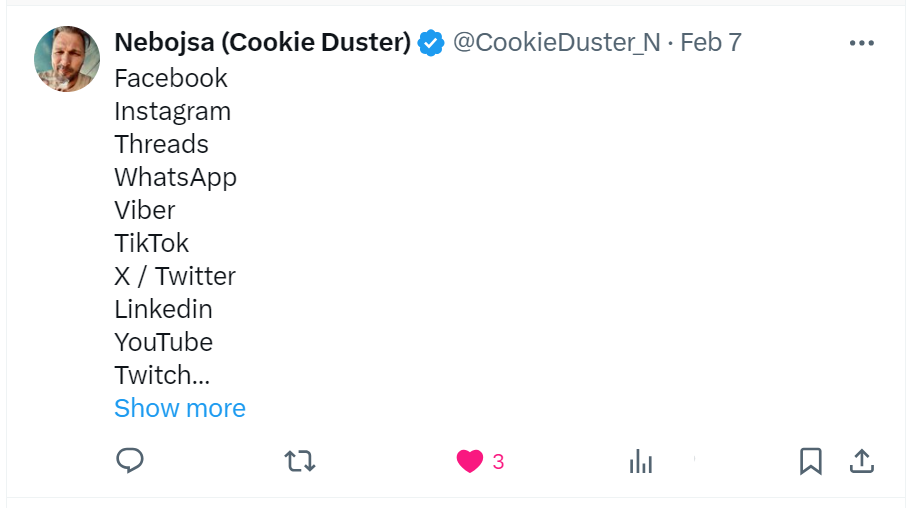eCommerce Marketing Strategies to Increase Traffic and Boost Revenue in 2024
Psst: we are hiring remote frontend developers and backend developers.

The global eCommerce sales for 2023 surpassed $6.5 trillion for all online products (). What can we expect this year? Well, can't be sure about the exact number, but I feel it will only go up.
While this rapid growth means more opportunities, it also means tougher competition where only the best make it. I've read somewhere you need to sell where everyone scrolls, searches, and shops. It's only partially true because you need to sell where YOUR audience is scrolling, searching, and shopping, not everyone.
How do you do that?
I'm glad you asked. With an effective marketing strategy that helps your businesses increase brand awareness, drive traffic, generate leads, and ultimately boost sales and revenue.
That's easier said than done🤔
While it is never good when you have to explain why you are doing something, this article (kind of) deserves it because it has been in the making for quite some time and comes as a sum of conversations with our clients and my personal meandering past and present experiences. The article is tailored for emerging eCommerce ventures and seasoned brands aiming to enhance their digital footprint. It's crucial to acknowledge the unique nature of each business, which means that not all strategies discussed may align with your specific business model and use case.
The key takeaway for you is to use this article as a starting point for developing a strategic framework that will help your business increase website traffic and elevate revenue.
Understand Your Target Audience
You won't get anywhere if you don't define your target audience. First, you'll need to gather demographic information, create , understand their pain points and needs, and how your products/services help address them.
Demographic information such as age, gender, location, income, and education level can help you better understand where your customer personas are coming from, and you can tailor your marketing messages to them.
Why is understanding your target audience important?
You wouldn't market soccer equipment to someone who only plays basketball, right? Imagine spending time and money promoting your product to someone who just doesn't have a use for it. We'd all prefer to avoid this- and it's precisely where your target audience comes in.
Understanding your target audience will help you create an effective marketing strategy. Moreover, it will enable you to tailor and personalize your messaging, promotions, and product offerings to address the needs and preferences of your target audience.
Importance of SEO in Driving Organic Traffic to Your eCommerce
is critical for driving organic traffic to your eCommerce site. While various search engines are not to be dismissed, with 91.47% of search engine market share worldwide in 2023 (), Google optimization should be a priority.
And it all starts with keyword research.
What your target audience is for your market strategy, keyword research is for your SEO strategy. It means identifying the words and phrases your target audience uses to search for products or services similar to yours.
Prioritize Brand Awareness Campaigns over Everything Else
Most people immediately trust longstanding brands. Establishing your brand as a trustworthy one, whatever your marketing channel is, should be the #1 priority.
[h3]Social Media Marketing
Social media is a powerful tool for building brand awareness, reaching new customers, and building credibility. It is one of the best channels for showcasing your brand’s personality, values, and products/services to a broad audience.
However, choosing the right one (or a couple) is becoming increasingly challenging (like to the below Tweet is here).

Before finalizing your social media marketing strategy, it's crucial to identify the most relevant platforms where your audience is most active and understand their expectations on these platforms. This knowledge enables you to tailor your strategy to engage effectively with them, ensuring your efforts are focused on the channels offering the most significant engagement and conversion potential.
For instance, if your target audience is predominantly Gen Z or millennials, platforms like TikTok and Instagram might be more effective than Facebook or LinkedIn. Similarly, if you're in the SaaS space, you'll hardly find a better platform than LinkedIn.
Know your product. Know your audience. Know where they hang out.
[h3]Email Marketing
Although it may seem outdated, email marketing is among the best business sales channels. In fact, , you can expect an average return of $40!
Additionally, email marketing is great at retaining customers and driving repeat sales. By building an email list and segmenting your subscribers based on their preferences, behaviors, and interests, you can send targeted and personalized messages that resonate with them.
To build an email list, you can offer incentives such as exclusive discounts, freebies, or content in exchange for their email address. Once you have a list, you can segment it based on purchase history, location, and interests and tailor your email campaigns accordingly.
For example, to those who bought SpongeBob SquarePants yellow socks (from our ), you can send a follow-up email with a one-time offer for a matching Squidward undershirt. Or an email with a 10% discount to everybody who bought something at your online store.
The more personalized you can get your email (and any other communications), the better your results will be. And, of course, the bigger your list, the more opportunities.
Be careful not to bug your customers too often. They appreciate you doing that even more.
[h3]Influencer Marketing
If you haven't tried influencer marketing yet, 2024 is the year to do it. You can collaborate with influencers with the following that aligns with your target audience to showcase your products/services to a broad yet relevant audience, building credibility in the process.
In the age of ads, users tend to believe influencers more than they would your Facebook ad. In fact, 72% of Gen Z and Millennials follow influencers on social media ().
That said, influencer marketing can get expensive quickly. You may be better off collaborating with a micro-influencer, depending on your budget, of course.
While their audience will be smaller (reflected in the lower price), they generally generate a higher engagement (up to 60% more engagement than macro-influencers) because their audience tends to be more niche and relevant.
To find the right influencers for your brand, follow your audience. Where do they hang out the most? For example, platforms like Instagram, YouTube, and TikTok are great for fashion and retail, while LinkedIn and X might be better options for SaaS companies. Wherever you go, search for those with solid followings and engagement rates (likes/comments/clicks per post).
Once you've identified potential collaborators, you can reach out to them and pitch your sponsored content ideas.
[h3]Content in eCommerce
In today's eCommerce landscape, content is crucial in driving engagement, building brand identity, and converting browsers into buyers. And it goes beyond product pages.
Detailed and compelling product descriptions alongside high-quality images and videos showcasing products in the best light can only do so much today. Customer reviews, ratings, and testimonials are more social proof than the actual content. What I'm talking here is not only that you need but it's expected from brands to create informative and engaging blog posts or articles related to their industry, products, or niche.
Proper content marketing efforts should address customer pain points, provide valuable insights, attract organic traffic, establish authority, and educate customers.
[newsletter]Sign up for Crystallize newsletter!
The only dev and business-oriented newsletter in the headless commerce space!
The Importance of Tech Behind Your Storefront
Businesses don’t talk nearly enough about the tech behind their storefronts because…well, it’s tech. On the other hand, the modern-day audience has high expectations regarding speed, performance, and experience with your online store. And so do search engines.
[h3]Performance Matters
Your matters for user experience, conversion, ad placements, and good old SEO.
Customers have high expectations for website speed, with studies showing that 47% of customers expect a website to load in two seconds or less ().
Slow loading times or glitches can lead to high bounce rates, lost sales, and negative customer experiences. To show you how much your business could benefit from performance gains, we've built a .
Furthermore, your website speed is another criterion that Google and other search engines use to rank your website. You may lose significant ranking points if loading takes a long time.
Performance largely depends on the tech behind your storefront. Traditional platforms, the ones most of us are used to (such as WordPress, Magento, Shopify, Drupal, etc.), might be easier to use but are notorious for code legacy and coad bloat issues influencing performance. Modern platforms relying on tend to be better from the get-go. Compressing images, reducing server response times, and minimizing the use of plugins and scripts are some ways to optimize your website speed.
Truth be told, any platform can be performant. If you tackle performance on your website, no matter what framework/platform you use, check our
[h3]Mobile Experiences Are More Important than Ever
As of the fourth quarter of 2023, smartphones constituted around 78 percent of retail site traffic globally (). People shop on their phones, and this percentage is likely only to go up.
Use responsive design to create mobile-friendly websites. This ensures that your website adapts to different screen sizes and resolutions. Optimizing website performance and page load times is even more critical for mobile users, who are likelier to abandon slow-loading websites.
[h3]Build Futureproof Tech Stack with Composable Architecture
The technology behind your storefront should be designed to support your business's growth and adapt to changing customer needs.
, which involves breaking down the tech stack into modular components, can provide the flexibility and scalability needed for eCommerce success.
This means you can easily add or remove components such as payment gateways, shipping providers, order handling, email, or PIM systems. When a new technology emerges, add it to your composable website. When another becomes outdated, remove it.
These components are independent so you won't have the constraints the traditional, monolithic websites put on you. Instead, you'll be able to quickly respond to changing marketing conditions and customer demands, thereby futureproofing your tech stack.
[h3]Frontend Frameworks
The ecosystem of frontend frameworks is experiencing such rapid growth that selecting the optimal framework for your online business or store has become daunting. Today, the array of available frontend frameworks, Next.js, Remix Run, Qwik, Astro, Svelte, etc., appears virtually limitless. Still, there are some that we believe deserve your attention more than others. Our post (update in progress) might hold the key for your next framework .. or at least offer an opinion you might consider.
Moving Forward
Besides your product/service, the effectiveness of your marketing strategy will determine your revenue and whether your eCommerce business succeeds or fails. That being said, it’s a lot of work.
Understanding your target audience, prioritizing SEO to drive organic traffic, and leveraging brand awareness campaigns through social media and email marketing are all proven strategies for success -- and ones you most likely have already dabbled in.
On the other hand, considering influencer marketing and optimizing your storefront technology can also help drive growth. If you haven’t yet tried those out, make sure first to discuss them with your team to determine the best direction for your business.
Start small, but think big, and you’ll get there.

